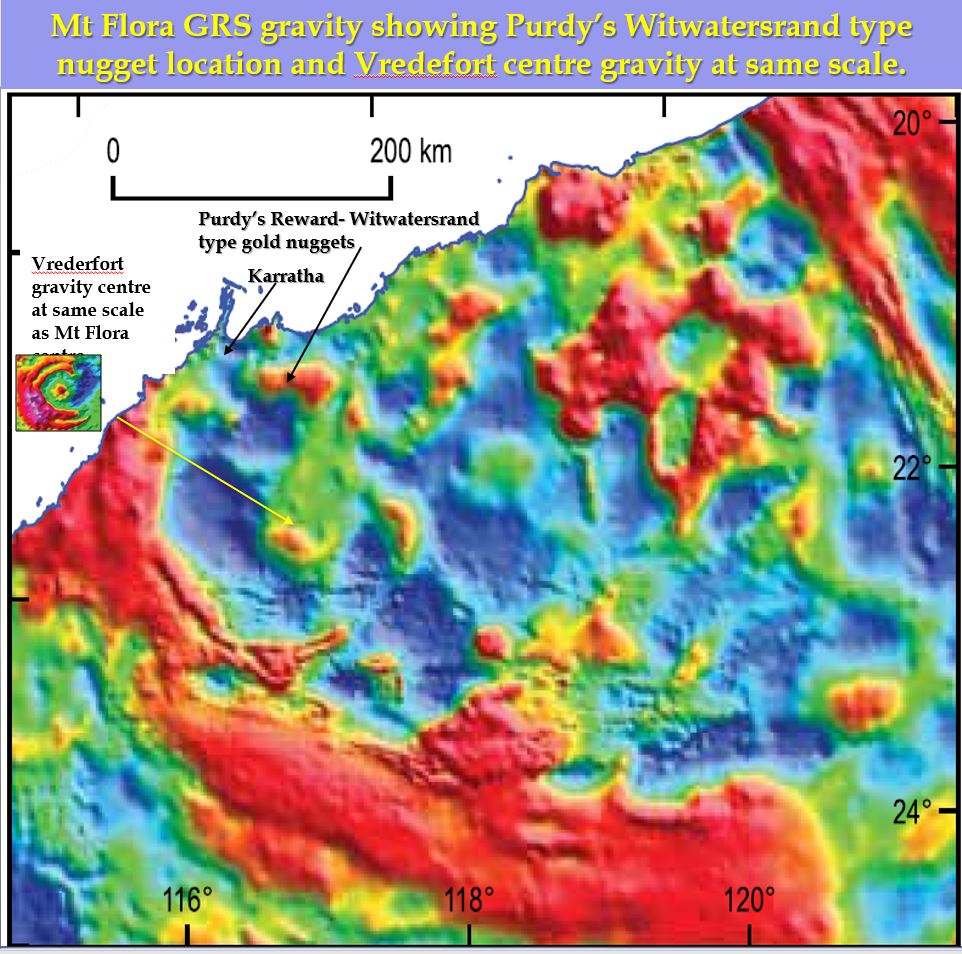
Archaean Impact Structure? 200km diameter Mt Flora Giant Ring Structure observed in West Pilbara Craton Australia.
This paper is the first in a series that will document the Mt Flora giant ring structure (GRS) in the West Pilbara Craton as observed in geoscientific data. The Mt Flora giant ring structure centre is located at 21˚ 45’S and 117˚00’E, about 120km south of Karratha and 20 km SW of Millstream National Park.These papers record empirical observations and are published as a springboard to advance research and exploration of the Pilbara. Speculation on a possible impact origin of the Archaean Mt Flora GRS is developed during the paper.
Mt Flora GRS was discovered in 2013 when ring structures in the Pilbara were being investigated using the gravity, magnetics and radiometrics images seen in the Blewett et al. 2012 Australia in Time and Space publication.
This research was dusted off because there is a lot of recent discussion on the similarity of the Pilbara to the Witwatersrand goldfield in South Africa and the exploration potential sparked by the discovery of many Witwatersrand type nuggets at Purdy’s Reward 40km SE of Karratha. Witwatersrand basin was formed by the Vredefort impact structure at 2.08 Ga. The main factor missing is evidence of a Vredefort type impact structure. This paper presents evidence for a giant ring structure (GRS) of the same size and timing as Vredefort to create a Witwatersrand type sedimentary basin in the Pilbara into which the source gold can be deposited. Gold mineralisation at Purdy’s Reward appears to be associated with the intersection of the Mt Flora outer gravity ring’s contact with the greenstones to the north.
Thus the rim of the Mt Flora GRS, especially where it intersects gold bearing greenstone/granite belts is prospective. That there were algal mats present to precipitate the gold has been well documented.
There are gold, and other minerals, exploration opportunities where these rings intersect mineralised zones. Preliminary targeting for Witwatersrand gold and iron is presented.
Archaean Impact Structure? Size, origin and age of the Mt Flora giant ring structure.
The Mt Flora GRS has many of the features of an impact structure. There are numerous concentric circles, albeit segmented. There is a strong 200km diameter ring observed in gravity, magnetic, radiometric, Landsat and geology data images. There is a 30km central high in gravity. The annulus between the centre and the outer ring is of lower gravity and magnetics than the regional data intensity. There are many segments of the farfield rings up to 600km from the centre suggesting an original diameter of 1200km.
The concentric nature and the morphology (Grieve and Pilkington 1996) of these rings suggest that the Mt Flora GRS may be an impact structure.
The age of the Mt Flora GRS is older than the base of the 2.775–2.630 Ga volcano-sedimentary Fortescue Group (Thorn and Kendall 2001) and may be as old as the age of the older 3.47 Ga spherulite beds in the East Pilbara (Glikson and Allen 2004).
Evidence in the Archaean Pilbara and adjoining Kaapvaal Cratons of several impact spherulite ejecta horizons confirm that large impacts occurred around 2.48, 2.63, 2.7 2.9? and 3.47 Ga (Simonson et al 2004, Hassler and Simonson 2001, Bryerly et al 2002, Glikson 2004, Glikson and Allen 2004, Glikson and Tonguç Uysal, 2013, Glikson et al. 2016).
Is Mt Flora GRS one of the impacts that caused these spherulite beds in the eastern Pilbara between 3.472 – 2.48 Ga? The impacts should still be visible in data relating to crust of that age even if the original surface expression of the Archaean impact is buried. Yarrabubba, in the northern Yilgarn Craton, is the only large verified Western Australian Archaean impact structure (Macdonald et al 2003) but is possibly too young, too far away and not large enough to have generated the spherulite beds.
To read full paper ….. Share with your colleagues … this paper gives new targeting information for the Wits Pilbara gold deposits —- click below ….
| a PF #1 mt Flora GRS introduction paper.pdf | 3 MB |

